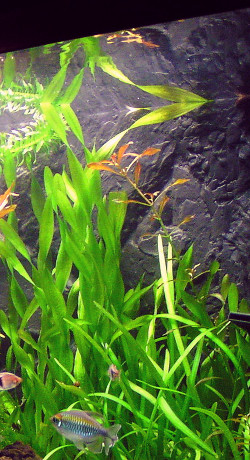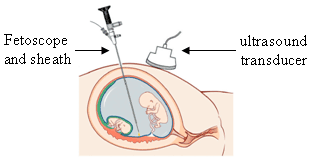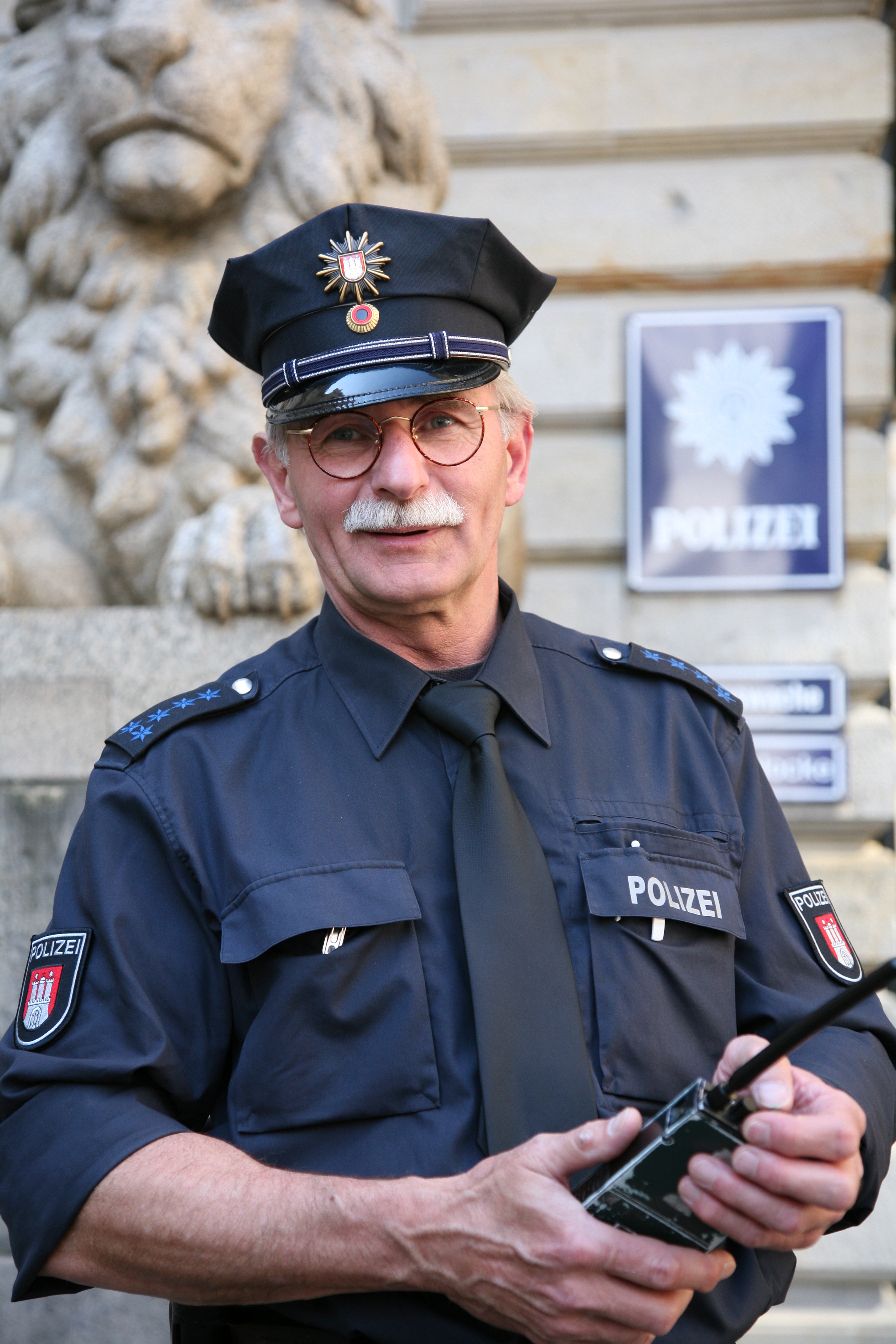|
Fiberscope
A fiberscope is a flexible optical fiber bundle with a lens on one end and an eyepiece or camera on the other. It is used to examine and inspect small, difficult-to-reach places such as the insides of machines, locks, and the human body. History Guiding of light by refraction, the principle that makes fiber optics possible, was first demonstrated by Daniel Colladon and Jacques Babinet in Paris in the early 1840s. Then in 1930, Heinrich Lamm, a German medical student, became the first person to put together a bundle of optical fibers to carry an image. These discoveries led to the invention of endoscopes and fiberscopes. In the 1960s the endoscope was upgraded with glass fiber, a flexible material that allowed light to transmit, even when bent. While this provided users with the capability of real-time observation, it did not provide them with the ability to take photographs. In 1964 the fiberscope, the first gastro camera, was invented. It was the first time an endoscope ... [...More Info...] [...Related Items...] OR: [Wikipedia] [Google] [Baidu] |
Total Internal Reflection
In physics, total internal reflection (TIR) is the phenomenon in which waves arriving at the interface (boundary) from one medium to another (e.g., from water to air) are not refracted into the second ("external") medium, but completely reflected back into the first ("internal") medium. It occurs when the second medium has a higher wave speed (i.e., lower refractive index) than the first, and the waves are incident at a sufficiently oblique angle on the interface. For example, the water-to-air surface in a typical fish tank, when viewed obliquely from below, reflects the underwater scene like a mirror with no loss of brightness (Fig.1). TIR occurs not only with electromagnetic waves such as light and microwaves, but also with other types of waves, including sound and water waves. If the waves are capable of forming a narrow beam (Fig.2), the reflection tends to be described in terms of " rays" rather than waves; in a medium whose properties are independent of direction, such ... [...More Info...] [...Related Items...] OR: [Wikipedia] [Google] [Baidu] |
Endoscope
An endoscope is an inspection instrument composed of image sensor, optical lens, light source and mechanical device, which is used to look deep into the body by way of openings such as the mouth or anus. A typical endoscope applies several modern technologies including optics, Human factors and ergonomics, ergonomics, precision mechanics, electronics, and software engineering. With an endoscope, it is possible to observe lesions that cannot be detected by X-ray, making it useful in medical diagnosis. An endoscope uses tubes only a few millimeters thick to transfer illumination in one direction and high-resolution video in the other, allowing minimally invasive surgeries. It is used to examine the internal organs like the throat or esophagus. Specialized instruments are named after their target organ. Examples include the cystoscope (bladder), Nephroscopy, nephroscope (kidney), Bronchoscopy, bronchoscope (bronchus), arthroscope (joints) and colonoscope (colon), and Laparoscopy, lapar ... [...More Info...] [...Related Items...] OR: [Wikipedia] [Google] [Baidu] |
Optical Fiber
An optical fiber, or optical fibre, is a flexible glass or plastic fiber that can transmit light from one end to the other. Such fibers find wide usage in fiber-optic communications, where they permit transmission over longer distances and at higher Bandwidth (computing), bandwidths (data transfer rates) than electrical cables. Fibers are used instead of metal wires because signals travel along them with less Attenuation, loss and are immune to electromagnetic interference. Fibers are also used for illumination (lighting), illumination and imaging, and are often wrapped in bundles so they may be used to carry light into, or images out of confined spaces, as in the case of a fiberscope. Specially designed fibers are also used for a variety of other applications, such as fiber optic sensors and fiber lasers. Glass optical fibers are typically made by Drawing (manufacturing), drawing, while plastic fibers can be made either by drawing or by extrusion. Optical fibers typically incl ... [...More Info...] [...Related Items...] OR: [Wikipedia] [Google] [Baidu] |
Police
The police are Law enforcement organization, a constituted body of Law enforcement officer, people empowered by a State (polity), state with the aim of Law enforcement, enforcing the law and protecting the Public order policing, public order as well as the public itself. This commonly includes ensuring the safety, health, and possessions of citizens, and to prevent crime and civil disorder. Their lawful powers encompass arrest and the use of force legitimized by the state via the monopoly on violence. The term is most commonly associated with the police forces of a sovereign state that are authorized to exercise the Law enforcement agency powers, police power of that state within a defined legal or territorial area of responsibility. Police forces are often defined as being separate from the military and other organizations involved in the defense of the state against foreign aggressors; however, gendarmerie are military units charged with civil policing. Police forces are usua ... [...More Info...] [...Related Items...] OR: [Wikipedia] [Google] [Baidu] |
Military
A military, also known collectively as armed forces, is a heavily armed, highly organized force primarily intended for warfare. Militaries are typically authorized and maintained by a sovereign state, with their members identifiable by a distinct military uniform. They may consist of one or more military branches such as an army, navy, air force, space force, marines, or coast guard. The main task of a military is usually defined as defence of their state and its interests against external armed threats. In broad usage, the terms "armed forces" and "military" are often synonymous, although in technical usage a distinction is sometimes made in which a country's armed forces may include other paramilitary forces such as armed police. Beyond warfare, the military may be employed in additional sanctioned and non-sanctioned functions within the state, including internal security threats, crowd control, promotion of political agendas, emergency services and reconstruct ... [...More Info...] [...Related Items...] OR: [Wikipedia] [Google] [Baidu] |
Pin Tumbler Lock
The pin tumbler lock, also known as the Yale lock after the inventor of the modern version, is a lock mechanism that uses pins of varying lengths to prevent the lock from opening without the correct key. Pin tumblers are most commonly employed in cylinder locks, but may also be found in tubular pin tumbler locks (also known as radial locks or ace locks). History The first known example of a tumbler lock was found in the ruins of the Palace of Khorsabad built by king Sargon II (721–705 BC.) in Iraq.James, Peter, and I. J. Thorpe. Ancient Inventions. New York: Ballantine, 1994. Basic principles of the pin tumbler lock may date as far back as 2000 BC in Egypt; the lock consisted of a wooden post affixed to the door and a horizontal bolt that slid into the post. The bolt had vertical openings into which a set of pins fitted. These could be lifted, using a key, to a sufficient height to allow the bolt to move and unlock the door. This wooden lock was one of Egy ... [...More Info...] [...Related Items...] OR: [Wikipedia] [Google] [Baidu] |
Locksmithing
Locksmithing is the work of creating and bypassing locks. Locksmithing is a traditional trade and in many countries requires completion of an apprenticeship. The level of formal education legally required varies by country, ranging from no formal education to a training certificate awarded by an employer, or a full diploma from an engineering college, along with time spent as an Apprenticeship, apprentice. Terminology A lock (security device), lock is a mechanism that secures buildings, rooms, cabinets, objects, or other storage facilities. A "smith" is a metalworker who shapes metal pieces, often using a forge or moulding (process), mould, into useful objects or to be part of a more complex structure. Thus locksmithing, as its name implies, is the assembly and designing of locks and their respective keys by hand. Most locksmiths use both automatic and manual cutting tools to mold keys, with many of these tools being powered by batteries or mains electricity. Work Locks have been ... [...More Info...] [...Related Items...] OR: [Wikipedia] [Google] [Baidu] |
Endoscopy
An endoscopy is a procedure used in medicine to look inside the body. The endoscopy procedure uses an endoscope to examine the interior of a hollow organ or cavity of the body. Unlike many other medical imaging techniques, endoscopes are inserted directly into the organ. There are many types of endoscopies. Depending on the site in the body and type of procedure, an endoscopy may be performed by a doctor or a surgeon. During the procedure, a patient may be fully conscious or anaesthesia, anaesthetised. Most often, the term ''endoscopy'' is used to refer to an examination of the upper part of the human gastrointestinal tract, gastrointestinal tract, known as an esophagogastroduodenoscopy. Similar instruments are called borescopes for nonmedical use. History Adolf Kussmaul was fascinated by sword swallowers who would insert a sword down their throat without gagging. This drew inspiration to insert a hollow tube for observation; the next problem to solve was how to shine light th ... [...More Info...] [...Related Items...] OR: [Wikipedia] [Google] [Baidu] |
Cystoscopy
Cystoscopy is endoscopy of the urinary bladder via the urethra. It is carried out with a cystoscope. The urethra is the tube that carries urine from the bladder to the outside of the body. The cystoscope has lenses like a telescope or microscope. These lenses let the physician focus on the inner surfaces of the urinary tract. Some cystoscopes use optical fibres (flexible glass fibres) that carry an image from the tip of the instrument to a viewing piece at the other end. Cystoscopes range from pediatric to adult and from the thickness of a pencil up to approximately 9 mm and have a light at the tip. Many cystoscopes have extra tubes to guide other instruments for surgical procedures to treat urinary problems. There are two main types of cystoscopy—flexible and rigid—differing in the flexibility of the cystoscope. Flexible cystoscopy is carried out with local anaesthesia on both sexes. Typically, a topical anesthetic, most often xylocaine gel (common brand names are ... [...More Info...] [...Related Items...] OR: [Wikipedia] [Google] [Baidu] |
Upper Gastrointestinal Endoscopy
Esophagogastroduodenoscopy (EGD) or oesophagogastroduodenoscopy (OGD), also called by various other names, is a diagnostic endoscopic procedure that visualizes the upper part of the gastrointestinal tract down to the duodenum. It is considered a minimally invasive procedure since it does not require an incision into one of the major body cavities and does not require any significant recovery after the procedure (unless sedation or anesthesia has been used). However, a sore throat is common. Alternative names The words ''esophagogastroduodenoscopy'' (EGD; American English) and ''oesophagogastroduodenoscopy'' (OGD; British English; see spelling differences) are pronounced . It is also called ''panendoscopy'' (PES) and ''upper GI endoscopy''. It is also often called just ''upper endoscopy'', ''upper GI'', or even just ''endoscopy''; because EGD is the most commonly performed type of endoscopy, the ambiguous term ''endoscopy'' is sometimes informally used to refer to EGD by defau ... [...More Info...] [...Related Items...] OR: [Wikipedia] [Google] [Baidu] |
Mediastinoscopy
Mediastinoscopy is a procedure that enables visualization of the contents of the mediastinum, usually for the purpose of obtaining a biopsy. Mediastinoscopy is often used for staging of lymph nodes of lung cancer or for diagnosing other conditions affecting structures in the mediastinum such as sarcoidosis or lymphoma. Mediastinoscopy involves making an incision approximately 1 cm above the suprasternal notch of the sternum, or breast bone. Dissection is carried out down to the pretracheal space and down to the carina Carina may refer to: Places Australia * Carina, Queensland, a suburb in Brisbane * Carina Heights, Queensland, a suburb in Brisbane * Carina, Victoria, a locality in Mildura Serbia * Carina, Osečina, a village in the Kolubara District .... A scope ( mediastinoscope) is then advanced into the created tunnel which provides a view of the mediastinum. The scope may provide direct visualization or may be attached to a video monitor. Mediastinoscopy pr ... [...More Info...] [...Related Items...] OR: [Wikipedia] [Google] [Baidu] |








